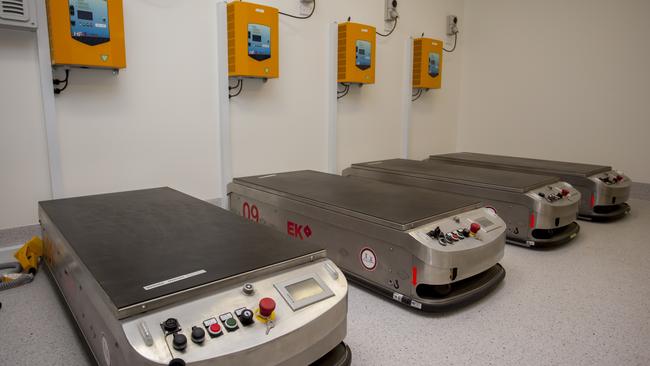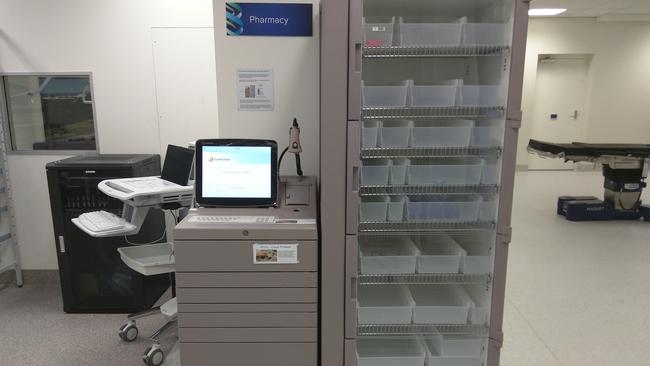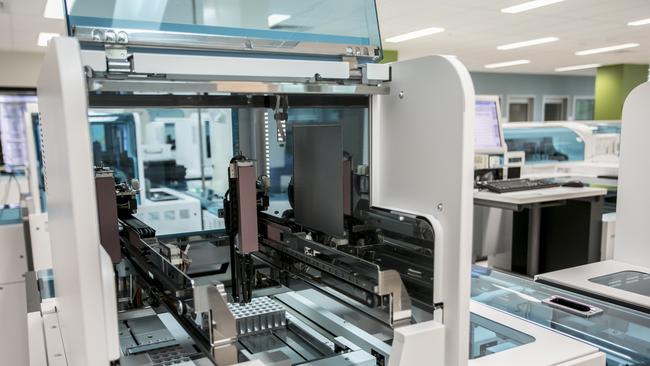FROM robots delivering the linens to electronic tags keeping track of equipment and even patients, the new Royal Adelaide Hospital is emerging as the hi-tech hospital of the future.
While the computer wizardry behind the infrastructure of the new Royal Adelaide Hospital makes it one of the world’s most advanced building projects, the general public will benefit in ways ranging from subtle to in-your-face.
New Royal Adelaide Hospital director commissioning Elke Kropf says the new hospital is more than just a building.
“It’s a hospital for the future,” she says. “Over the last decade, there have been so many advances in technology in so many industries and health has often lagged behind. I think the hospital is built for the next 70 to 100 years, so we do have to invest in technology to get more efficient and to allow staff to actually process more patients.”
Ms Kropf is especially excited about the Automated Guided Vehicles, or AGVs — stainless steel robotic devices that can carry large trolleys with goods at average walking pace and can talk to lifts, specific doors and portable phones.

Then there’s the Automated Pharmacy Distribution System and Automated Pharmacy Cabinets which will make the access of medication easier, faster and safer.
“Our pharmacy staff are incredibly excited to be moving from a very manual system to an automated system,” Ms Kropf says.
The new Royal Adelaide Hospital has been built to adapt to further changes if new technology should become available.
“It is often referred to as the most technologically advanced hospital in Australia, so wherever possible we are using technology to assist staff in providing better care,” Ms Kropf says.
Behind the scenes
A technological revolution is unfolding behind the scenes of the new Royal Adelaide Hospital. Here is what is happening:
Automated Guided Vehicles
Linen, waste, meals and pharmacy supplies will be transported through the hospital on robots. It’s hoped the so-called Automated Guided Vehicles (AGVs) will reduce manual work for staff and give them more time to focus on patient care.
They are flat, stainless steel robotic devices, measuring 1.7m in length, 60cm in width and just over 30cm in height, that can carry large trolleys with goods at average walking pace and can talk to lifts, specific doors and portable phones.
A fleet of 25 AGVs will be employed to move more than 1800 trolleys of goods each day. Most staff and patients will never encounter an AGV. They work quietly away in the background to ensure essential supplies are delivered.

Automated Dispensing Cabinets
Prescribed medications will be at the fingertips of doctors and nurses at the new RAH thanks to Automated Dispensing Cabinets (ADCs). The new RAH’s network of 117 ADCs will provide 24/7 access to an increased range of medications through fingerprint or password login.
The computer-controlled dispensing cabinets will be installed in all inpatient wings. SA Pharmacy executive director Steve Morris says the sophisticated electronic system will be used to order, dispense and track medicine.
“The ADCs will replace the numerous shelves and cupboards that currently serve as drug storage areas and will increase safety and efficiency, allowing clinicians to spend more time caring for their patients,” he says.
“The added security of locked storage compartments will enable more medications to be stocked directly on the floor. The ADCs will also keep an electronic record of transactions and provide real-time reports detailing who removed what drug, when and for which patient.”
Total Lab Automation
The largest fully automated microbiology laboratory in the southern hemisphere, located at the new RAH, has been hailed as world-class technology to diagnose and treat infectious diseases, such as pneumonia and meningitis.
The $4 million BD Kiestra Total Lab Automation (TLA) will help the new hospital to fully automate the processing of specimens, including blood, urine and wound swabs.
SA Pathology acting executive director Dr Janice Fletcher says the technology is a “game changer” for managing infectious diseases in South Australia. “(It will be) replacing the laboratory-intensive manual techniques required to detect bacteria,” she says. “This innovative technology will significantly shorten the time it takes to get the vital information clinicians need to decide on the best course of treatment for their patients.”
The system is believed to speed up results by 40 per cent and improve efficiency and accuracy in the lab, where more than 300,000 patient samples are incubated and tested each year.

Digital instrument tracking system
The department looking after sterilising the instruments at the Royal Adelaide Hospital will undergo a robotic revolution when it moves to the new hospital. The Central Sterile Services Department (CSSD) will replace its cumbersome paper records with a sophisticated electronic system for tracking the RAH’s vast collection of medical instruments.
Automated Guided Vehicles will also be used to deliver supplies.
Central Adelaide Local Health Network clinical director of surgical services Professor Guy Maddern says the new RAH will be the state’s only public hospital to roll out a digital instrument tracking system. About 40 staff work to clean 26,000 instruments a day for use in heart, spine, orthopedics, vascular, eye, ear, nose and throat surgeries.
“The CSSD and its technicians are the heartbeat of our hospital, working behind the scenes to ensure our surgeons and medical practitioners are prepared to deliver lifesaving care,” Professor Maddern says.

Pneumatic Tube System
Small pathology and pharmacy items will be shot through tubes to be sent quickly and securely to clinical areas at the new hospital.
The Pneumatic Tube System (PTS) stations will be located in pathology, pharmacy, mortuary, acute medical and surgical units, emergency, mental health, radiotherapy, renal, nuclear medicine, pathology, cancer day, phlebotomy, intensive care, technical suites and outpatient and inpatient wings.
The system can monitor the location and check the appropriate speed of the carrier with the small items, as each carrier is equipped with a radio frequency identification (RFID) chip.
The PTS has more than 3km of tubing and 74 stations around the hospital.
Gone techy
Wireless patient nurse call system
Wi-Fi technology will enable nurses to respond to patients wherever they are, before attending to them in their rooms.
Electronic bedside devices
At the touch of a button, patients will be able to manage their in-room entertainment and order meals. Food orders for individual patients will take into account things like allergies and if the patient has to fast.
Distributed medical imaging
Medical imaging will work on a distributed model, with machines located in various sections of the hospital, rather than in one central location. This will reduce the need to move patients around the hospital and prevent delays to inpatient and outpatient scans.
Electronic tags
Electronic tags will allow staff to quickly check the whereabouts of equipment to prevent theft and cut time searching for wheelchairs and the likes. Tags will also be put on at-risk patients with alerts automatically being sent to staff should they leave a restricted area.
Self-serve electronic kiosks
They will give directions and print out maps for visitors, freeing up staff.



Our flagship hospital: Your questions answered
CHAPTER 1: The new Royal Adelaide Hospital has been hailed as being at the top of its class in modern health care. But the project faced plenty of road blocks before construction even started.
What’s changed at the Royal Adelaide Hospital
CHAPTER 2: Improved models of care, advanced technology and use of robotics — the new Royal Adelaide Hospital in the city’s west is light years from its predecessors.